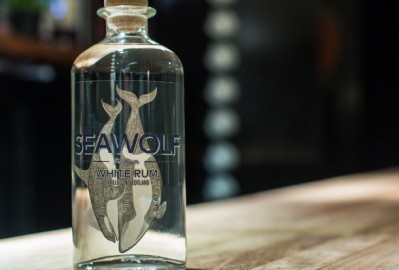Rum's the word
Rum's all white in the pub but the amber, golden and aged varieties are tickling the fancy in top-end bars. Ben McFarland samples a tot or two.
For a spirit with such a murky past, the future for rum is looking rather rosy. More versatile than a chameleon in a paint shop and with the flexibility of a double-jointed ballerina, rum is currently floating the boats of UK bartenders and proving that it's not just a tipple for sea dogs and shipmates but for young, trendy landlubbers as well.
The rums setting sail in the style bar sector, for instance, are not of the clear white or dark navy variety but golden rums and aged rums riding high on the back of sought-after cocktails such as the mojito, the daiquiri and planters punch.
In pubs, however, white rum reigns and pours supreme, accounting for more than two-thirds of sales and expected to grow. The omnipotent Bacardi is present in more than nine out of 10 bars according to this year's Publican Brands Report 2003 and, alongside Smirnoff vodka, is vying for the number one position in the white spirit category.
Notwithstanding Malibu, the coconut rum enjoying somewhat of a renaissance thanks to a major marketing push by owner Allied Domecq, it is Bacardi Carta Blanca that springs to the mind of most when rum is on the agenda. However, those licensees who restrict their range of rums to just the market leader are giving pub-goers a rum deal, no pun intended... honest.
Bacardi, for instance, has more in its locker than just its Carta Blanca brand such as Bacardi eight-year-old, an aged rum matured in hand-made oak casks, Bacardi Oro, a golden rum aged in charred American white oak barrels for between two and three years, and Bacardi 151, a notorious rum with an ABV of 75.5 per cent - so potent it is illegal to take it on an aeroplane.
Bacardi's main rival in the style bar sector, where its grip on proceedings is by no means as tight as the mainstream market, is Havana Club, owned by Pernod Ricard.
As the only authentic Cuban rum available on these shores, Havana Club has developed a strong following among cocktail drinkers and is a popular "pouring" brand among top-end outlets.
Having usurped Bacardi as the preferred rum in the JD Wetherspoon pub estate earlier this year, Havana Club moved quickly to preserve its premium credentials by releasing a Havana Club Anejo Blanco white rum specifically designed for the mainstream pub market.
More adventurous publicans, however, should further explore the Havana Club portfolio where they will discover Havana Club three-year-old, Havana Club Anejo Reserva and Havana Club seven-year-old - a trio of well-respected rums that are best sipped with a Havana Cuban cigar, not a splash of cola.
From Cuba, puddle jump east a few hundred miles and you'll arrive in Barbados, home to Mount Gay, where the rums are mellower than a laid back local listening to dinner jazz on a very comfy chaise longue.
Mount Gay, part of the Maxxium UK stable, is celebrating its 300th anniversary this year. To mark the occasion it has released a strictly limited edition blend of Mount Gay Rum with only 3,000 released in a specially designed tricentennial decanter.
Another Caribbean rum yet to make the shift from cocktail culture to the local is the Appleton range from Jamaica. Appleton V/X, a spicy amber rum, and Appleton Special, a light golden rum, are both pushed heavily in premium outlets by owner Wray and Nephew.
Brand manager for Appleton Andreas Redlefsen described it as the "cognac of the Caribbean". He said: "It's very similar to a whisky and cognac and a lot smoother than other spirits but people don't realise this as golden rum is relatively new in the UK - it's misunderstood with more to offer than navy and white rum.
"If the rum sector works together and educates the consumer then there's no reason why aged and premium rums can't make the transition into the pub market."
Slaves and sea dogs
- Slaves... In the 16th century, rum was heavily associated with the brutal triangular slave trade. Black slaves taken from West Africa were transported in ships to the Caribbean islands where they were sold in exchange for molasses. These same ships, laden with molasses, were taken to the North American colonies and exchanged or sold to convert into rum before crossing the Atlantic once more and arriving in Europe.
...and sea dogs In 1677, the British government decided to issue all Navy ratings with a daily rum ration called a "tot".
The admiralty issued a generous, yet hopelessly impractical, ration of half-a-pint of neat rum a day! By 1740, not best pleased with tales of drunken sailors (what do you do with them?), the ration was wisely supplemented with water and continued to be moderated until the 20th century when it was a far more sensible eighth-of-a-pint tot.
It wasn't until August 1, 1970, that the tot was discontinued - thereafter a day known in the Royal Navy as "black tot day".
How is rum made?
- Raw materials
It might not sound particularly fancy, but rum is made from a by-product of sugar cane. Sweet sap found in sugar cane is used to make sugar but the thick, treacle-like residue known as molasses is the key ingredient of rum.
There is some rum (from the French West Indies, Brazil and South Africa) that is produced separately from the sugar-making process. Here the sugar cane is squeezed to produce a juice that is then converted into rum through fermentation and distillation.
Distillation
There are two methods of distillation. The first is in "goose" neck pot stills, the style favoured by cognac and whisky distilleries, to produce a more robust and heavy rum.
Or, adopting a more modern approach, rum can also be distilled in column stills where impurities can be removed more easily. As such, these stills are more suitable for lighter rum styles.
Ageing
As with all other spirits, rum is completely colourless when it comes off the still and when it goes into barrels to be aged it is clear like water. Rum is, for the most part, matured in oak barrels but some use barrels previously used for bourbon or cognac. During maturation the rum draws tannin, colour and flavour from the wood and the smaller the cask, the greater the influence it has on the complexity of the rum.
Light-bodied rums such as Bacardi Carta Blanca will stay in wood for one to three years.
A minimum three-year stretch is required for medium to heavy-bodied rums while aged rums can spend any amount of time in cask. Rums can be offered at seven, eight, 12, 15 and 21 years and some even older but it's worth noting where the maturation takes place as it occurs much faster in the tropics than the colder, damper climates of Europe.
Colour and flavouring
Much of rum's colour is taken from the wood, depending on the size and style of the barrel, but "golden" and "dark" rums achieve their amber or dark colours through the addition of caramel.
When used, however, caramel can affect the rum's flavour and bouquet.
Blending
Rums are blended in order to highlight the sought-after flavours and mask any unfavourable aspects.
There are very few rums available in the UK that aren't blended, with most brands a combination of both pot still and column still rums.
Rum-makers can combine a number of rums from different islands and different ages, but the age on the label must apply to the youngest component in the blend.
Spiced rums
Spiced rums only represent a minimal share of the UK rum market and attempts to grow the category in the past have not been particularly successful.
Diageo, however, has high hopes for Morgan Spiced having acquir
















